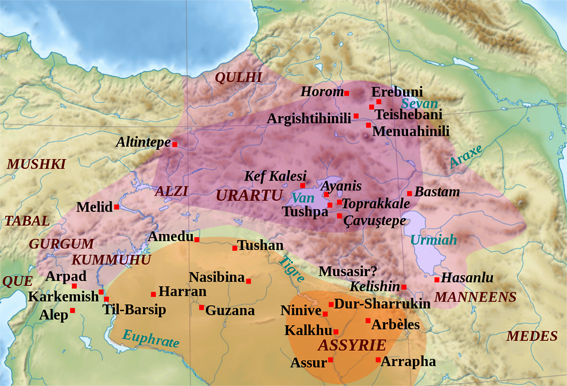
Map of the approximate expansion of the kingdom of Urartu, with its maximum extent in 750 BC Source: Wikiwand
Dr. Kantian Is Trying to Correct a Historic Misattribution
by Muriel Mirak-Weissbach
FRANKFURT, OCTOBER 13, 2022 — Loss of life is the greatest cost of war, and in the continuing Azerbaijani aggression against Artsakh and the Republic of Armenia, casualties have been high. Along with destroying human lives, expelling Armenians and devastating their property, Azerbaijan has pursued a campaign to erase evidence of the physical and cultural existence of the Armenian people in the region. This includes destroying cultural and religious monuments, turning churches into mosques, and changing place names.
Raffi Kantian, chairman of the German-Armenian Society (DAG) and editor of their journal, Armenian-German Correspondence (ADK), has recently exposed a related case of mistaken cultural identity in an important venue in Germany. And, happily, his intervention should lead to a restoration of the truth.
Pictures of an Exhibition
It all began, as documented on the DAG website (https://www.deutscharmenischegesellschaft.de/), in late summer, when two photos posted on Facebook made the rounds. The pictures are from the Archaeological Museum in Frankfurt (Main), and depict Urartian exhibits and a map. Kantian examined the images, then posed the question: “What does Urartu have to do with Azerbaijan?” In fact, the showcase was labelled “Azerbaijan.” Kantian also asked why the map accompanying the exhibit should also bear the name “Azerbaijan.”
It is well-known, he wrote, that the Baku regime has consistently tried to find Azerbaijani footprints everywhere, claiming that not only Yerevan and a Persian mosque in the Armenian capital, were Azerbaijani, but also that southern Armenia itself had long been part of Azerbaijan. Perhaps, he noted, here was yet another attempt at the same falsification.
What’s in a Name?
Dr. Kantian then laid out the historical facts of the matter. “The empire of Urartu, according to our current knowledge, collapsed in the 7th century B.C. At that time, there were no Turkic tribes, to whom today’s Azerbaijanis feel they are related. It was only centuries later that Turkic tribes migrated to these regions.” Kantian’s conclusion was that it is absurd to speak of ‘Azerbaijan’ when referring to a region around Lake Urmia on a historical map.
As he clarified further, the term “Azerbaijan” in use today is derived from the name of the satrap Atropates, (Old Persian Atarepata), in the 4th century B.C. Centuries later, the territory he governed would become known as Āturpātakān (Middle Persian). “That was a purely geographical designation for the region in north-western Iran and says nothing about the ethnic composition of the population there.” He added that the term “Azerbaijan” does not appear on any serious map of the period.
Continuing his historical account, Kantian notes that the term has become even more problematic since 1918, when on May 17, the founders of the so-called Democratic Republic of Azerbaijan (DRA), from the Musavat Party, chose that name deliberately for political reasons, which had to do with the fact that neighboring Iran also had an Azerbaijan region. This led to confusion as well as political irritation.
For Kantian, this is also the problem raised by the exhibit in Frankfurt. “Which Azerbaijan is meant? The province in the Islamic Republic of Iran, today’s Republic of Azerbaijan, or both?” He notes that the Baku government has abused such ambiguity for its own purposes, even with a view to suggesting that Iranians in that province should separate from the Islamic Republic. This is something that was discussed in the 1990s and even recently has been mooted on a website linked to the Azerbaijan presidency (“Die Zeit ist reif: Süd-Aserbaidschan sollte sich vom Iran abspalten,” August 26, 2022, Caliber.az, https://bit.ly/3d5Q6wh)
Mistaken Identity
What do the Frankfurt Museum authorities say? Kantian sent them a summary account of the case, and requested that they correct the erroneous designation. In response, Dr. Wolfgang David, Director of the Archeological Museum, acknowledged the problem and agreed to make amends. “We regret that you were irritated by exhibited objects and their labelling in one of our showcases. The Urartu kingdom stretched out over many states, as you yourself write. The pieces in our exhibit however come from excavation sites in the current day Azerbaijan province of Iran around Lake Urmia. So, the label on the showcase could have led to the misunderstanding.”
The director explained furthermore that the exhibition had been organized in the 1980s and had not been updated since; there are plans to do so soon, and “in this context, we will certainly make changes which will also include the map,” he wrote. Though the museum would need time to make these and other changes, he assured Kantian in his letter that “in the meantime, we have removed the designation ‘Azerbaijan’ in the showcase, which in this concrete case referred to the origin of the exhibits from the north-western province of Iran and will also review the texts again.”